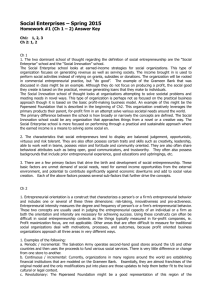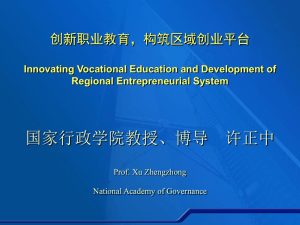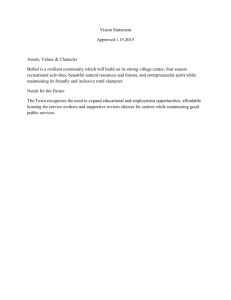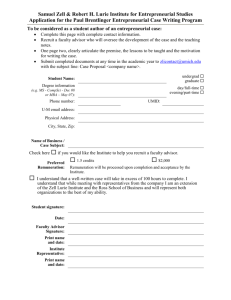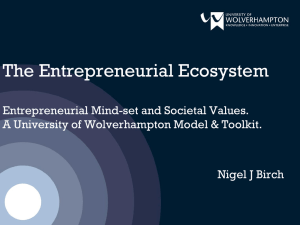Research on Entrepreneurial Opportunity Evaluation - PUC-SP
advertisement
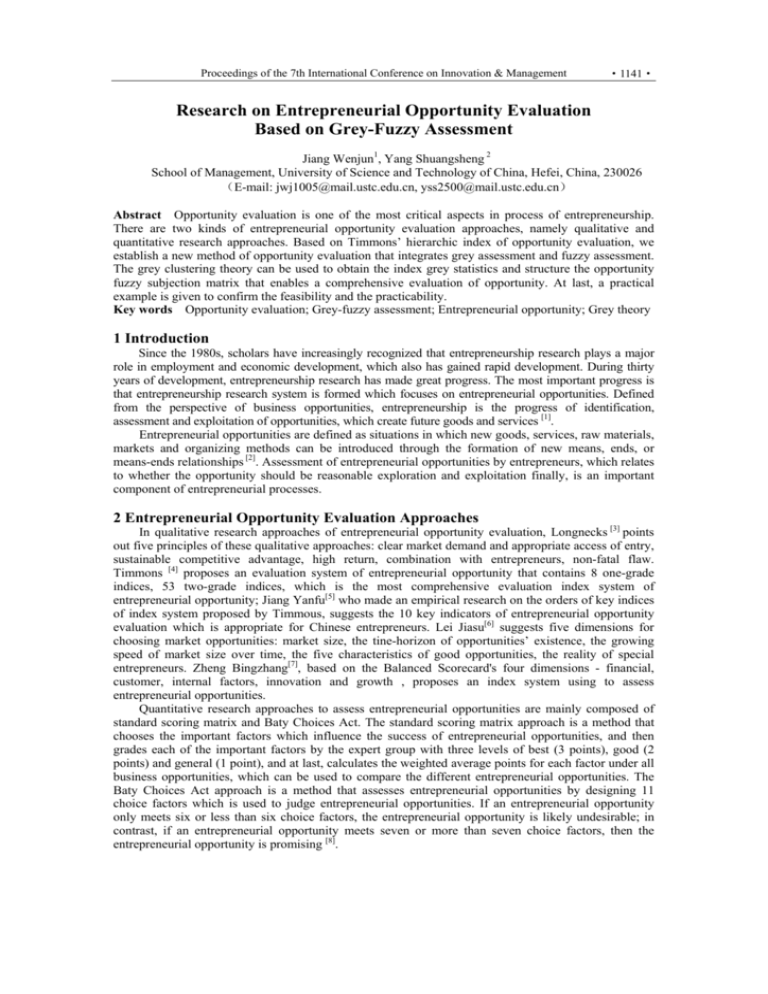
Proceedings of the 7th International Conference on Innovation & Management
·1141·
Research on Entrepreneurial Opportunity Evaluation
Based on Grey-Fuzzy Assessment
Jiang Wenjun1, Yang Shuangsheng 2
School of Management, University of Science and Technology of China, Hefei, China, 230026
(E-mail: jwj1005@mail.ustc.edu.cn, yss2500@mail.ustc.edu.cn)
Abstract Opportunity evaluation is one of the most critical aspects in process of entrepreneurship.
There are two kinds of entrepreneurial opportunity evaluation approaches, namely qualitative and
quantitative research approaches. Based on Timmons’ hierarchic index of opportunity evaluation, we
establish a new method of opportunity evaluation that integrates grey assessment and fuzzy assessment.
The grey clustering theory can be used to obtain the index grey statistics and structure the opportunity
fuzzy subjection matrix that enables a comprehensive evaluation of opportunity. At last, a practical
example is given to confirm the feasibility and the practicability.
Key words Opportunity evaluation; Grey-fuzzy assessment; Entrepreneurial opportunity; Grey theory
1 Introduction
Since the 1980s, scholars have increasingly recognized that entrepreneurship research plays a major
role in employment and economic development, which also has gained rapid development. During thirty
years of development, entrepreneurship research has made great progress. The most important progress is
that entrepreneurship research system is formed which focuses on entrepreneurial opportunities. Defined
from the perspective of business opportunities, entrepreneurship is the progress of identification,
assessment and exploitation of opportunities, which create future goods and services [1].
Entrepreneurial opportunities are defined as situations in which new goods, services, raw materials,
markets and organizing methods can be introduced through the formation of new means, ends, or
means-ends relationships [2]. Assessment of entrepreneurial opportunities by entrepreneurs, which relates
to whether the opportunity should be reasonable exploration and exploitation finally, is an important
component of entrepreneurial processes.
2 Entrepreneurial Opportunity Evaluation Approaches
In qualitative research approaches of entrepreneurial opportunity evaluation, Longnecks [3] points
out five principles of these qualitative approaches: clear market demand and appropriate access of entry,
sustainable competitive advantage, high return, combination with entrepreneurs, non-fatal flaw.
Timmons [4] proposes an evaluation system of entrepreneurial opportunity that contains 8 one-grade
indices, 53 two-grade indices, which is the most comprehensive evaluation index system of
entrepreneurial opportunity; Jiang Yanfu[5] who made an empirical research on the orders of key indices
of index system proposed by Timmous, suggests the 10 key indicators of entrepreneurial opportunity
evaluation which is appropriate for Chinese entrepreneurs. Lei Jiasu[6] suggests five dimensions for
choosing market opportunities: market size, the tine-horizon of opportunities’ existence, the growing
speed of market size over time, the five characteristics of good opportunities, the reality of special
entrepreneurs. Zheng Bingzhang[7], based on the Balanced Scorecard's four dimensions - financial,
customer, internal factors, innovation and growth , proposes an index system using to assess
entrepreneurial opportunities.
Quantitative research approaches to assess entrepreneurial opportunities are mainly composed of
standard scoring matrix and Baty Choices Act. The standard scoring matrix approach is a method that
chooses the important factors which influence the success of entrepreneurial opportunities, and then
grades each of the important factors by the expert group with three levels of best (3 points), good (2
points) and general (1 point), and at last, calculates the weighted average points for each factor under all
business opportunities, which can be used to compare the different entrepreneurial opportunities. The
Baty Choices Act approach is a method that assesses entrepreneurial opportunities by designing 11
choice factors which is used to judge entrepreneurial opportunities. If an entrepreneurial opportunity
only meets six or less than six choice factors, the entrepreneurial opportunity is likely undesirable; in
contrast, if an entrepreneurial opportunity meets seven or more than seven choice factors, then the
entrepreneurial opportunity is promising [8].
·1142·
Proceedings of the 7th International Conference on Innovation & Management
The pure qualitative assessment approaches have some shorts, which would be difficult to give
orders of several entrepreneurial opportunities; quantitative assessment methods also have two shorts.
One short is that the division of assessment dimensions is less reasonable, which appears one-sidedness
and overlapping and neglects the effect of mutual coupling between indices on the program. The other
short is the lack of combination of subjective and objective assessment. Appraisers are subject to the
constraints of knowledge and information, as well as personal preferences, and so assessment
information provided by them is often incomplete or inadequate. To some extent, this affects the
effectiveness of opportunity assessment.
There are two types of uncertainty in assessment of entrepreneurial opportunities. First, Uncertainty
is caused by unclear and incomplete information, namely grey; second, the boundary of assessment
indices is not obvious, and a number of factors that impact assessment are ambiguous, namely fuzzy.
Only using simple fuzzy approach leads to the loss of information, while only using grey method is hard
to reflect possible cross-fuzzy defined by assessment indices. Therefore, during entrepreneurial
opportunity evaluation with dual uncertainty, grey-fuzzy comprehensive assessment model is a scientific
and effective method for assessment.
3 Grey-fuzzy Assessment Approach
3.1 Identification of the index system
Though comprehensive comparison of assessment index system of entrepreneurial opportunities
from domestic and foreign scholars, the evaluation criteria suggested by Timmons[4] is relatively
comprehensive, almost covering full content argued by other theories. The index system includes 8
categories of one-grade index, 53 categories of two-grade index, and respectively portrays the maximum
and minimum potential of each index. So it can be as an evaluation index system of entrepreneurial
opportunity. It is showed in table 1.
1) Industry and Market. High potential entrepreneurial opportunities should satisfy these conditions:
customers can accept companies’ products or services and are willing to pay for them; products have
high value to customers; products have a long life term; the project is in a new industry and competition
is imperfect; the industry market has large sales and its potential sales can reach from 10 million to1
billion; the growth rate of industry market is more than 30-50%; the productive capacity of existing
firms within the industry is almost completely saturated; within 5 years, the enterprise can occupy the
leading position in the market and the market share can reach 20% above; the enterprise have low-cost
suppliers.
2) Economic factors. High potential entrepreneurial opportunities should satisfy these conditions:
the need of time to reach break-even point is less than 1.5-2 years; the break-even point will not
gradually increase; investment rate of return and internal rate of return will be potential over 25%;
project funding requirements are not great, and have access to financing; the growth rate of sales is
higher than 15%; it can provide sustainable gross margin and gross margin is above 40%; it can provide
long-lasting after-tax profit, and after-tax profit margin is more than 10%; assets to sales ratio is low;
spontaneous flow of capital requirement is low; Research & Development (R & D) on capital
requirements is low.
3) Harvest conditions. High potential entrepreneurial opportunities should satisfy these conditions:
the added value brought by projects has relatively high strategic significance; capital market valuation
multiples of enterprises are relatively high and have the historical comparability; there are existing or
foreseeable exit strategies; capital market environment is favorable and capital flows can be achieved.
4) Competitive advantage. High potential entrepreneurial opportunities should satisfy these
conditions: fixed and variable costs are low; the control of costs, prices and sales is high; it can obtain
patent protection of ownership; competitors respond slowly and indifferently; it has legal or contractual
exclusivity; it has well-developed network of relationships and has easy access to the contract; it has
excellent key personnel and management team.
5) Management team. High potential entrepreneurial opportunities should satisfy these conditions:
the entrepreneurial team is a combination of excellent managers; industry and technology experience of
teams should achieve the highest levels of our own industry; the degree of integrity and honesty of
teams should achieve the highest standard; the team should know which aspects of knowledge is lack.
6) Fatal flaw. High potential entrepreneurial opportunities should not have any fatal flaws.
7) Entrepreneur's personal standards. High potential entrepreneurial opportunities should satisfy
conditions: entrepreneur's personal goals is consistent with entrepreneurial activities; the opportunity
Proceedings of the 7th International Conference on Innovation & Management
·1143·
can enable entrepreneurs to achieve the success of limited risks; entrepreneurs can receive the salary
reduction and other losses; entrepreneurs are eager to start this kind of entrepreneurial life manner, not
only to make a lot of money; entrepreneurs can bear appropriate risks and grow well under pressure.
8) Strategic difference. High potential entrepreneurial opportunities should satisfy these conditions:
business drivers are fit to the external environment; corporate management team has been the best; there
are good service concepts in customer service management; the founder of the business trends to the
times; the adopted technology has a breakthrough, which does not have many alternative products or
competitors; it has flexible adaptability and can quickly make decisions to go on or give up; always look
for new opportunities; pricing of our own firm keeps nearly flat with the market leader; have access to
sales channels, or have existing network; allow mistakes and failures.
Table 1 Evaluation Index System of Entrepreneurial Opportunity
Attractiveness of opportunities ( uij )
No. i
1
One-grade
index
industry
and market
No. j
Two-grade index
1
Product/service
customer acceptance
2
product value
No. i
4
4
influence of product
on markets
4
product life
6
5
industry structure
7
6
market size
1
7
industry growth rate
9
10
1
2
3
4
5
6
7
8
9
10
11
1
2
3
harvest
conditions
3
4
4
competitive
advantage
competitive
advantage
3
8
economic
No. j
3
5
2
One-grade
index
1
2
productive capability
of existing firms
availability
of
market share
cost structure
6
time
to
reach
break-even point
whether break-even
point can increase
potentiality of investment
rate of return
7
potentiality of internal
rate of return
capital requirements
of projects
growth rate of sales
spontaneous
flow
capital
gross margin
after-tax profit
after-tax profit
the capital requirement
of R&D
strategic value
8
valuation multiples
withdrawal
mechanism
Capital
market environment
fixed and variable
costs
the control of costs,
prices and sales
Management
team
5
2
3
4
Two-grade index
patent protection of
ownership
competitors’
responding time
legal or contractual
advantages
relationships
and
network
key personnel
component
of
entrepreneurial teams
industry & technology
experience of team
Team integrity and
honesty
Team awareness and
honesty
Fatal flaw
1
2
Personal
standards
3
opportunity cost
4
entrepreneurial
Intentions
5
risk / reward tolerance
6
6
7
stress tolerance
consistence of drivers
with environment
team level
service management
access time
technology
breakthrough
strategic flexibility
opportunity-oriented
8
pricing strategy
9
distribution channels
10
fault-tolerant space
1
2
3
4
5
Strategic
difference
consistence
in
personal & firm goals
risk of opportunity to
entrepreneurs
·1144·
Proceedings of the 7th International Conference on Innovation & Management
3.2 Grey-fuzzy assessment model
1) Determine the evaluation factors set. The evaluation factors set is:
U = {u1 , u2 ,..., u8 } , where ui = ui1 , ui 2 ,..., uij , L , uin , (i = 1, 2, L ,8) .
{
}
2) Design an opportunity remark set. The opportunity remark set is designed as:
V = {v1 , v2 ,..., v5 } , v1 , v2 ,L, v5 respectively mean index remarks as "excellent", "good", "Medium" , "poor"
and "worst", the corresponding score of 5,4,3,2, 1.
3) Determine the weight set of evaluation indices. The weight is used to describe the relative importance
of various indices to assessing purpose. Weights can be obtained by an average score calculated through
experts’ remarks in the form of distributed assessment, the Delphi method and AHP.
W = {w1 , w2 ,..., w8 } , where wi ∈ [ 0,1] and ∑ i =1 wi = 1, (i = 1, 2, L ,8).
8
wi = {wi1 , wi 2 ,..., win } , where wij ∈ [ 0,1] and ∑ j =1 wij = 1, ( j = 1, 2, L , n).
n
4) Organize assessment experts to remark each of evaluation factors for opportunities. Experts k (k=1,
2, ..., m) give remarks d ijk to opportunities uij , then we can obtain an evaluation matrix Di of the index
i:
⎡ di11 di12 L di1m ⎤
⎢d
di 22 L di 2 m ⎥⎥
i 21
⎢
Di =
(1)
⎢ M
M O
M ⎥
⎢
⎥
⎣⎢ dij1 dij 2 L dijm ⎦⎥
5) Establish the evaluation grey type. As constraints of experts’ level and differences of cognition, we
can just only give the number of a grey whitening value. In order to truly reflect the degree of a special
category which experts’ remarks belong to, we need to determine the whitening weight function [9].
According to score grading standards, we obtain five assessment grey categories: e = 1, 2, ... , 5. And the
evaluation remarks of the corresponding is respectively "excellent", "good", "medium", "poor," "worst."
And the corresponding Whitening weight functions as follows [10]:
The first grey category is defined as “highest” (e=1). And design grey number as ⊗1 ∈ [5, ∞ ] , the
whitening weight function as f1 :
⎧dijk / 5
⎪
f1 ( dijk ) = ⎨ 1
⎪ 0
⎩
dijk ∈ [ 0,5]
dijk ∈ [5, ∞]
dijk ∉ [ 0, ∞]
(2)
The second grey category is defined as “high” (e=2). And design grey number as ⊗2 ∈ [ 0, 4,8] , the
whitening weight function as f 2 :
⎧ dijk / 4
dijk ∈[ 0,4]
⎪
f2 ( dijk ) = ⎨( 8 − dijk ) / 4
dijk ∈[ 4,8]
(3)
⎪
dijk ∉[ 0,8]
0
⎩
The third grey category is defined as “medium” (e=3). And design grey number as ⊗3 ∈ [ 0,3, 6] ,
the whitening weight function as f3 :
⎧ dijk / 3
⎪
f3 ( dijk ) = ⎨( 6 − dijk ) / 3
⎪
0
⎩
The forth grey category is defined as “low”
dijk ∈[ 0,3]
dijk ∈[3,6]
dijk ∉[ 0,6]
(4)
(e=4). And design grey number as ⊗4 ∈ [ 0, 2, 4] , the
whitening weight function as f 4 :
⎧ dijk / 2
⎪
f 4 ( dijk ) = ⎨( 4 − dijk ) / 2
⎪
0
⎩
dijk ∈ [ 0, 2]
dijk ∈ [ 2, 4]
dijk ∉ [ 0, 4]
(5)
Proceedings of the 7th International Conference on Innovation & Management
·1145·
The fifth grey category is defined as “lowest” (e=5). And design grey number as ⊗5 ∈ [ 0,1, 2] , the
whitening weight function as f5 :
⎧ dijk / 1
⎪
f5 ( dijk ) = ⎨( 2 − dijk ) / 1
⎪
0
⎩
dijk ∈ [ 0,1]
dijk ∈ [1, 2]
(6)
dijk ∉ [ 0, 2]
6) Calculate the grey weight value rije of each d ijk according to f e ( dijk )(e=1, 2, 3, 4, 5), and establish
the fuzzy membership matrix. Suppose the evaluation ratio yije is the e-th evaluation grey category of
opportunity assessment index uij , and yije = ∑ k =1 f e ( dijk ) . The total grey evaluation ratio
m
is yij = ∑ e =1 yije which belongs to uij . The fuzzy membership from uij to the remark set V is rije =
5
yije
yij
and ∑ e =1 rije = 1 . The single factor fuzzy evaluation matrix Ri of the evaluation index i is:
5
⎡ ri11
⎢r
i 21
Ri = ⎢
⎢ M
⎢
⎣⎢ rij1
ri12
ri 22
M
rij 2
L ri15 ⎤
L ri 25 ⎥⎥
O M ⎥
⎥
L rij 5 ⎦⎥
(7)
7) Overall evaluation. The overall evaluation value of factor i is Bi = [b1 , b2 ,..., b5 ] = wi o Ri , ( i = 1, 2,...,8 ) ,
and the symbol “ o ” means weighted calculation.
(8)
R = [ B1 , B2 ,..., B8 ]T
Then calculate R using the fuzzy matrix, and we can obtain a systemic fuzzy assessment matrix M:
M = [ M 1 , M 2 ,..., M 5 ] = W o R
(9)
At last, we know the overall evaluation value of opportunities through C = M ⋅ V T .
4 A Practical Example
In this paper, we study an entrepreneurial team in Hefei, and use the evaluation index system and
model to evaluate the entrepreneurial opportunities which they face. The team was formed in September
2009 and has 6 members, whose average age is 26 years old. And most of members have associate
degree. In the early years, the team's principal business is agent of SIM cards and network cards of
telecommunications carriers. Now the team has developed to have five self-employed business hall and
act for a comprehensive range of business operators. Now the team faces the choice of the following
three opportunities.
Opportunity S1: increase sales of SIM cards and network cards and focus on becoming an
outstanding agent of operators.
Opportunity S2: develop application software, and commit to becoming an application developer in
the 3G industry, such as remote medical care system.
Opportunity S3: run hotel chain, and commit to being a well-known regional chain hotel.
Invite five experts in the University of Science and Technology School of China of Management to
score 53 indices of the evaluation system. And then calculate the average of each index. At last, obtain
all the weights of the one-grade and two-grade indices.
W = {0.111, 0.115, 0.123, 0.112, 0.135, 0.145, 0.125, 0.135}
w1 = {0.137, 0.080, 0.089, 0.061, 0.105, 0.099, 0.125, 0.105, 0.112, 0.086}
w2 = {0.089, 0.070, 0.115, 0.112, 0.087, 0.098, 0.075, 0.089, 0.109, 0.070, 0.086}
w3 = {0.266, 0.295, 0.216, 0.223}
w4 = {0.136, 0.163, 0.158, 0.090, 0.127, 0.122, 0.204}
w5 = {0.301, 0.268, 0.196, 0.235}
w6 = {1.000}
·1146·
Proceedings of the 7th International Conference on Innovation & Management
w7 = {0.175, 0.170, 0.142, 0.165, 0.170, 0.179}
w8 = {0.073, 0.110, 0.115, 0.107, 0.102, 0.094, 0.084, 0.068, 0.081, 0.065}
Please five experts in the University of Science and Technology School of China of Management
to score every assessment indices of three opportunities. And obtain the evaluation matrix. Then
calculate the evaluation matrix according to approaches from part Ⅲ. At last, we gain the fuzzy
assessment matrix of three opportunities.
M S 1 = [ 0.3450, 0.3210, 0.0728, 0.0176, 0.0012]
M S 2 = [ 0.2602, 0.2752, 0.0616, 0.0284, 0.0032]
M S 3 = [ 0.2114, 0.2518, 0.0592, 0.0482, 0.0019]
V= {5, 4,3, 2,1} , according to C = M ⋅ V T , we can calculate the overall values of three opportunities,
respectively as 3.2637, 2.6468, 2.3397. So opportunity S1 is the best appropriate opportunity to the
team.
5 Conclusions
The entrepreneurial opportunity evaluation approach based on grey-fuzzy assessment has two
advantages. First, it rationally makes use of experts’ knowledge to overcome evaluator's subjective
dependence. Second, it considers the effect of cross-cutting and coupling between evaluation indices on
projects, reducing the difficulty of the evaluation index system measurement and the human factor error
during the evaluation process. The empirical study implies that the grey-fuzzy evaluation method is
feasible and effective to evaluate entrepreneurial opportunities.
References
[1] Shane, S, and Venkataraman, S. The promise of entrepreneurship as a field of research [J]. Academy
of Management Review,2000,25(1): 217-226
[2] Eckhardt, J, and Shane, S. Opportunities and Entrepreneurship[J]. Journal of Management, 2003,
29(3): 333-349
[3] Justin G. Longenecker, Carlos W. Moore, et al. Small Business Management: An Entrepreneurial
Emphasis, 13th [M]. USA: South-Western College Pub, 2006
[4] Timmons J .New Venture Creation:Entrepreneurship for 21st Century, 5th [M]. New York:
McGraw –Hill, 1999
[5] Jiang Yanfu, Qiu Qiong. An empirical study on the important criteria sequence of entrepreneurial
opportunity evaluation [J]. Studies in Science of Science, 2004, 22(1): 59-63(In Chinese)
[6] Lei Jiasu, Feng Wanling. High-tech Entrepreneurial Management [M]. Beijing: China Machine
Press,2001(In Chinese)
[7] Zhang Bing, Zhu Yankong, et al. On the Entrepreneurial Opportunity Evaluation Index based on the
BSC theory [J]. Contemporary Economy & Management, 2008, 30(6):38-41(In Chinese)
[8] John G. Burch,Entrepreneurship[M]. USA: John Wiley & Sons,1986
[9] Liu Siming, Xie Naifeng. Grey system theory and its application [M]. Beijing: Science Press, 2008:
17-24(In Chinese)
[10] Hu Shenghuang. The multi-level grey evaluation method of Subjective Index Evaluation [J].
Systems Engineering theory & Practice, 1996, 22 (1): 36-41(In Chinese)

